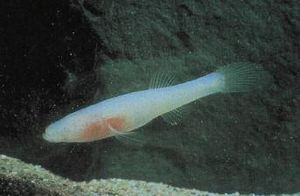Ozark cavefish facts for kids
Quick facts for kids Ozark cavefish |
|
|---|---|
 |
|
| Conservation status | |
| Scientific classification | |
| Genus: |
Amblyopsis
|
| Species: |
rosae
|
The Ozark cavefish (Amblyopsis rosae) is a small fish. It lives in underground freshwater in the United States. This fish is only found in certain areas.
Since 1984, the Ozark cavefish has been listed as a threatened species in the U.S. The IUCN says it is "Near Threatened." The Missouri Department of Conservation lists it as endangered. This means its numbers are low and it needs protection.
The Ozark cavefish is pinkish-white. It grows to about 2 inches (5 cm) long. Its head is flat, and its lower jaw sticks out a little. This fish does not have pelvic fins. Its dorsal and anal fins are set further back than on most fish. It has very simple eyes that do not work. It also lacks an optic nerve. The Ozark cavefish lives only in caves. It has no color and has lost some body parts it doesn't need. However, it has special sensory papillae that help it feel its way around in the dark. These fish mostly eat tiny living things. They also eat small crustaceans and young salamanders. They do not have many babies compared to other fish.
Where Ozark Cavefish Live
Caves where Ozark cavefish live usually have lots of food. This food can come from bat droppings (called guano) or leaves blown into the cave. The water in these caves is usually very clean. These fish can live in water with very little oxygen. This is common in underground water. Cavefish prefer to live in flowing cave streams. They do not like quiet pools as much.
The Ozark cavefish can get food from tree roots. These roots grow down into the cave. The roots are full of nutrients and water. They bring energy from the sun into the cave. This helps the cavefish and other creatures find food.
Where to Find Ozark Cavefish
The Ozark cavefish lives in a specific area. This area includes northeastern Oklahoma, northwestern Arkansas, and southwestern Missouri. These fish are native to the Springfield Plateau. This is part of the Ozark Highlands.
Right now, scientists have found 15 caves with Ozark cavefish. In Oklahoma, they are found in Delaware County. They were also found in Ottawa and Mayes Counties in the past.
Several things have caused the number of Ozark cavefish to drop. These include:
- Their homes being destroyed.
- People collecting them.
- Cave explorers disturbing them.


